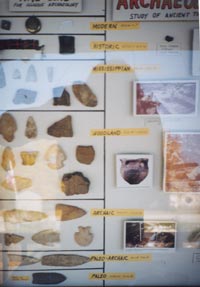NATIVE ECOSYSTEM RESTORATION
History of the Restoration Site
--Evolution of Illinois Native Ecosystems
--Local Natural and Human History
Role of Buffer Sites in Preserving Biodiversity
Project Goals and Purpose
Restoration Strategy and Methods
Site Biodiversity
Education and Outreach
Project Participants
|
Local Natural and Human History Some 15,000 years ago, the 10 Hickory Lane buffer recovery site most likely was under mile-high glaciers as was the present day Chicagoland region. Gradually, the ice melted and receded, and tundra colonized the land. Over time, boreal forests of pine and spruce replaced the tundra. As the climate grew warmer and drier, oaks and hickories, the native hardwoods of the present day, moved in and prairie expanded its range into Illinois from the south and west. In those times, wildlife was abundant, including bison, elk, bear and wolves (now all extinct in the wild in Illinois), and Paleo Indians depended upon nature's bounty for their survival. Artifacts dating back to 8,000 B.C. have been found in the region. More recently, the outposts and campsites of the Potawatomi village of "Sauganakka" occupied what is now the Wolf Road Prairie/Oak Brook area of western Cook and eastern DuPage Counties.  arrowheads and artifacts
photo by Phil Cihlar After the Blackhawk War and following the Treaty of 1833, Native Americans were displaced from their Illinois lands and moved west beyond the Mississippi River. By 1852, scattered farmsteads were replacing original Illinois ecosystems, and the tiny community of Franzosenbusch was established at what is now the intersection of Cermak and Wolf Roads in Westchester and Hillside. As recently as 175 years ago, Illinois was still a pristine wilderness of prairie, savanna, forest and wetland -- a place where the air was clean and the water was pure. Today, less then 1/100th of 1% of prairie remains and most of Illinois' wetlands, original landscapes, streams and forests have been drained, farmed, developed, polluted or timbered. The Village of Westchester was incorporated in 1925, but Wolf Road Prairie remained undeveloped and undisturbed. By the late 1940s and early 1950s, Hickory Lane Estates, the site of the recovery project, was established and parcelled into twelve 5-acre homesites. 10 Hickory Lane is one of the twelve properties within this beautiful and spacious landscape. The buffer recovery site on 10 Hickory Lane is an historic remnant of the previously vast native landscapes of the Chicagoland region. Pre-settlement oaks stand on the property, shading the intermittent stream which once ran with clear water pure enough to drink. |